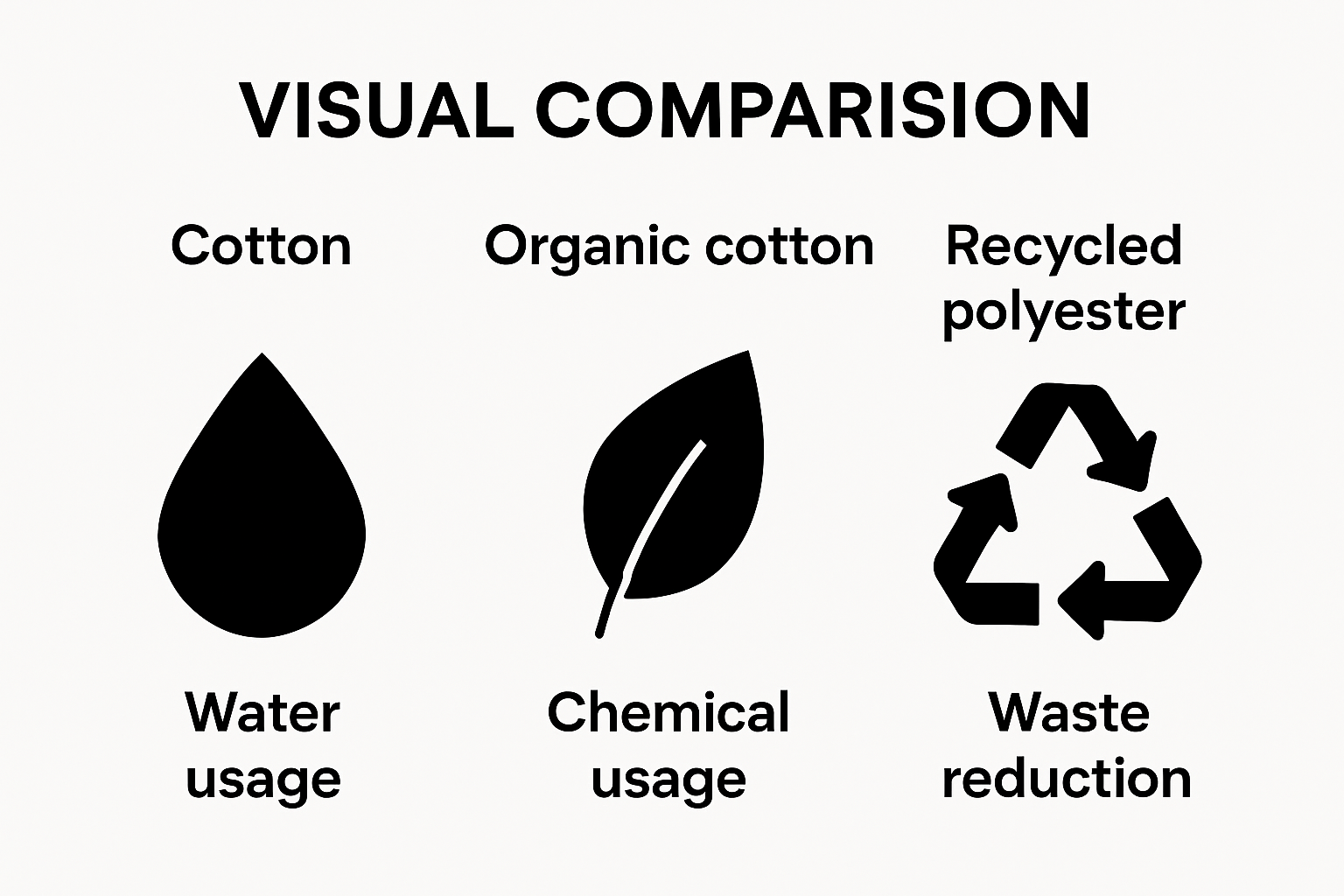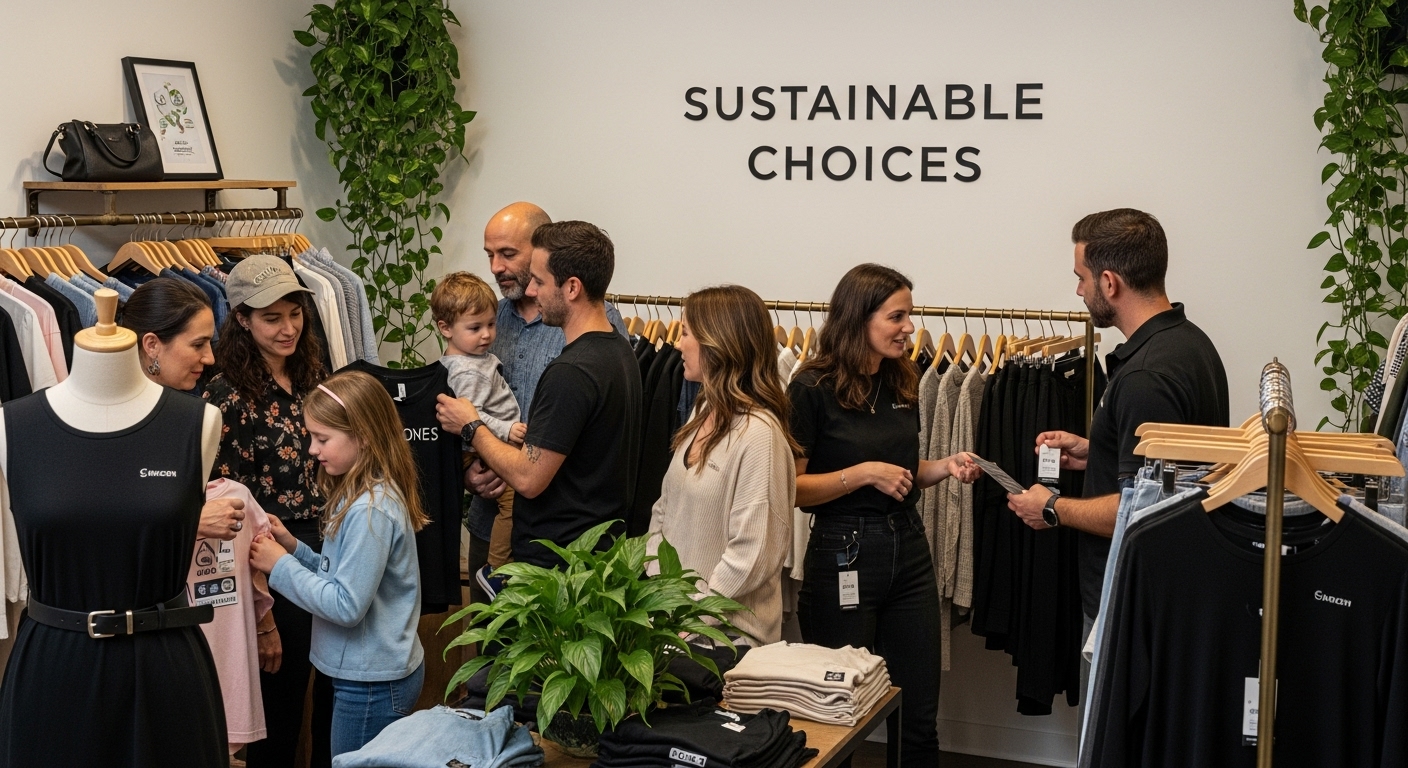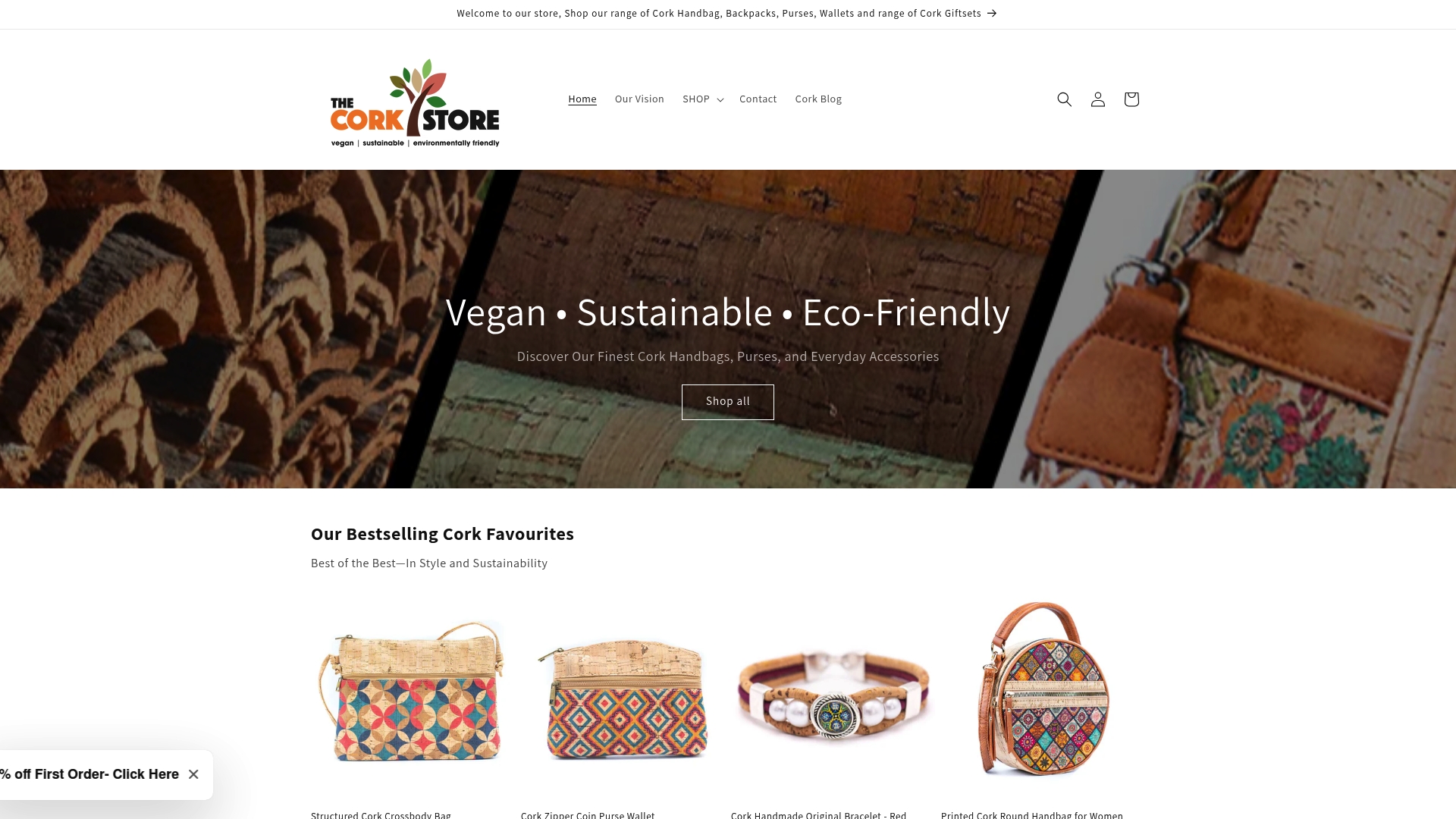
Understanding the Role of Eco-Friendly Materials in Fashion
Share
Eco-friendly materials are changing the way fashion is made and worn. The fashion industry alone generates 1.2 billion tonnes of carbon emissions each year, more than flights and shipping combined. Most people focus on trendy fabrics or celebrity outfits, but the real impact lies in the hidden details. The fibres used in our clothes could decide whether the planet warms or recovers.
To aid comprehension, the following table organises the distinctive characteristics that differentiate eco-friendly materials from conventional textiles in fashion production.
| Feature | Eco-Friendly Materials | Conventional Materials |
|---|---|---|
| Environmental Footprint | Low | High |
| Sourcing | Renewable/Recycled | Often Non-renewable |
| Water and Energy Consumption | Minimal | High |
| Chemical Processing | Reduced | Extensive |
| End-of-Life | Biodegradable/Recyclable | Often Non-biodegradable |
| Example Material | Cork | Standard Cotton/Polyester |
Table of Contents
- What Are Eco-Friendly Materials In Fashion?
- Why Eco-Friendly Materials Matter For Sustainability
- How Eco-Friendly Materials Impact The Fashion Industry
- Key Concepts Behind Eco-Friendly Fashion Choices
Quick Summary
| Takeaway | Explanation |
|---|---|
| Eco-friendly materials reduce environmental impact. | Selecting sustainable textiles significantly lowers carbon emissions and resource consumption in fashion production. |
| Sustainable practices enhance economic opportunities. | Eco-friendly materials can improve working conditions and create jobs within local communities across the textile supply chain. |
| Consumer demand drives sustainable fashion innovation. | Growing consumer awareness pushes brands to adopt eco-friendly practices to meet market expectations and promote responsible consumption. |
| Circular economy redefines fashion production. | Embracing a circular model encourages recycling and reuse, reducing waste and fostering sustainability in the fashion industry. |
| Material lifecycle assessments are crucial. | Evaluating the environmental impact of textiles throughout their lifecycle informs better choices and promotes long-term sustainability. |
What are Eco-Friendly Materials in Fashion?
Eco-friendly materials in fashion represent a transformative approach to clothing and accessory production that prioritises environmental sustainability and ethical manufacturing processes. These materials are specifically designed to minimise negative ecological impact while providing high-quality, stylish alternatives to traditional textiles.
Defining Sustainable Material Characteristics
At their core, eco-friendly materials possess several distinctive attributes that set them apart from conventional textile production. These materials are typically characterised by:
- Low environmental footprint during production
- Renewable or recycled sourcing
- Minimal water and energy consumption
- Biodegradable or recyclable properties
- Reduced chemical processing
Sustainable textiles can originate from diverse sources, ranging from natural plant fibres to innovative recycled synthetic materials. Cork, for instance, represents an exceptional example of an eco-friendly material that offers durability, versatility, and minimal environmental degradation.
Environmental Impact and Material Selection
The selection of eco-friendly materials directly influences fashion’s broader environmental footprint. According to Ellen MacArthur Foundation, the textile industry generates approximately 1.2 billion tonnes of carbon dioxide equivalent annually, representing more global emissions than international flights and maritime shipping combined.
By transitioning towards materials like organic cotton, hemp, bamboo, recycled polyester, and innovative plant-based alternatives, fashion brands can significantly reduce their ecological impact. These materials not only consume fewer resources during production but also offer enhanced biodegradability and reduced waste generation.

Ultimately, eco-friendly materials in fashion represent more than a trend they constitute a critical strategy for environmental conservation and responsible consumption. As consumers become increasingly aware of fashion’s environmental consequences, the demand for sustainable, ethically produced textiles continues to grow, driving innovation and transformation within the global fashion industry.
Why Eco-Friendly Materials Matter for Sustainability
Sustainability in fashion transcends mere aesthetic choices, representing a profound commitment to environmental stewardship and responsible resource management. Eco-friendly materials serve as critical instruments in addressing the fashion industry’s substantial ecological footprint, transforming manufacturing processes from extractive to regenerative practices.
Climate Change and Resource Conservation
The fashion industry’s environmental impact extends far beyond clothing production. Textile manufacturing consumes enormous quantities of water, energy, and raw materials, contributing significantly to global carbon emissions and ecological degradation. By prioritising eco-friendly materials, brands can substantially mitigate these environmental challenges.
The table below summarises the key environmental and socio-economic benefits linked with the adoption of eco-friendly materials as discussed in the section.
| Benefit Category | Description |
|---|---|
| Greenhouse Gas Reduction | Lower emissions throughout the material lifecycle |
| Water Conservation | Reduced water use during cultivation and processing |
| Chemical Pollution Minimisation | Fewer toxic substances released into ecosystems |
| Biodiversity Preservation | Less habitat destruction; supports natural systems |
| Waste Reduction | Lower solid waste through biodegradability and recyclability |
| Economic Opportunity | Supports job creation in local communities |
| Social Equity | Improves working conditions for textile workers |
Key environmental benefits of sustainable materials include:
- Reduced greenhouse gas emissions
- Minimised water consumption
- Lower chemical pollution
- Enhanced biodiversity preservation
- Decreased waste generation
Economic and Social Implications
Beyond environmental considerations, eco-friendly materials generate broader economic and social advantages. According to United Nations Environment Programme, sustainable textile practices can create new employment opportunities, support local communities, and drive technological innovation across global supply chains.
Materials like organic cotton, recycled polyester, and innovative plant-based textiles demonstrate how sustainable production can simultaneously address environmental concerns and economic development. These materials require less water, reduce toxic chemical usage, and often provide more equitable working conditions for textile workers.
The transition towards eco-friendly materials represents more than an environmental imperative it signifies a fundamental reimagining of fashion’s relationship with our planet. By embracing sustainable textile technologies, the fashion industry can become a powerful catalyst for positive ecological and social transformation, creating a more responsible and regenerative global ecosystem.
How Eco-Friendly Materials Impact the Fashion Industry
The integration of eco-friendly materials represents a profound transformation within the fashion industry, challenging traditional manufacturing paradigms and reshaping entire production ecosystems. This shift extends beyond aesthetic considerations, fundamentally reimagining how clothing and accessories are conceptualised, produced, and consumed.
Production Process Transformation
Eco-friendly materials catalyse comprehensive changes throughout fashion supply chains, compelling brands to reconsider manufacturing methodologies. Traditional textile production often involves resource-intensive processes with significant environmental consequences. By contrast, sustainable materials demand innovative approaches that prioritise efficiency, waste reduction, and circular economic principles.
Key transformative impacts include:
- Redesigning manufacturing infrastructure
- Implementing advanced recycling technologies
- Developing alternative material sourcing strategies
- Creating closed-loop production systems
- Reducing overall environmental degradation
Consumer Perception and Market Dynamics
Consumer awareness has dramatically shifted market expectations, with increasing demand for transparent, environmentally responsible fashion choices. According to McKinsey & Company, approximately 67% of consumers consider sustainability an essential factor when purchasing clothing and accessories.
This evolving consumer consciousness compels fashion brands to integrate eco-friendly materials not just as an ethical choice, but as a critical business strategy. Materials like recycled polyester, organic cotton, and innovative plant-based textiles are no longer niche offerings but mainstream expectations.
The fashion industry’s adoption of eco-friendly materials represents more than technological innovation it signifies a fundamental cultural shift towards responsible consumption. By embracing sustainable materials, brands can simultaneously address environmental challenges, meet consumer expectations, and contribute to a more regenerative global textile ecosystem.
Key Concepts Behind Eco-Friendly Fashion Choices
Eco-friendly fashion choices represent a holistic approach to textile production and consumption that prioritises environmental responsibility, ethical manufacturing, and long-term sustainability. These choices are founded on complex principles that extend far beyond superficial environmental considerations.
Material Selection and Lifecycle Assessment
Sustainable material selection involves comprehensive evaluation of environmental impact throughout a textile’s entire lifecycle. This means examining every stage from raw material extraction to manufacturing, distribution, usage, and eventual disposal or recycling.
Critical considerations in material selection include:
- Carbon footprint during production
- Water consumption requirements
- Chemical processing techniques
- Potential for recycling or biodegradation
- Social and ethical manufacturing conditions
Circular Economy and Design Philosophy
The circular economy model fundamentally transforms traditional linear fashion production processes. Instead of the conventional make-use-dispose approach, this philosophy emphasises continuous material reuse, regeneration, and minimal waste generation.
According to Ellen MacArthur Foundation, circular design principles encourage creating products that can be effectively recycled, repaired, or biodegraded, thereby reducing environmental strain and promoting resource efficiency.
Eco-friendly fashion choices are not merely about selecting alternative materials but reimagining the entire relationship between consumers, manufacturers, and the global environment. By embracing comprehensive sustainability strategies, the fashion industry can transition from being an environmental burden to becoming a catalyst for positive ecological transformation.

Step Into Sustainable Style With Cork Accessories
If you are looking to make a real difference in sustainable fashion and want to minimise your environmental impact, now is the perfect time to choose accessories made from eco-friendly materials. As you read in our article, switching to materials that offer a low environmental footprint and are both renewable and cruelty-free is essential for positive change. Many traditional options fall short in supporting ethical production and responsible consumption, a concern often echoed by those seeking to align style with their values.

Discover the new standard in ethical accessories with The Cork Store. Our curated collection of vegan cork handbags, wallets, and gift sets bridges the gap between sustainability, quality, and timeless design. Cork delivers the durable, stylish, and cruelty-free alternative you have been searching for. Do not wait to make eco-friendly fashion part of your daily life. Visit https://thecorkstore.co.uk today and take the first step towards a more responsible wardrobe.
Frequently Asked Questions
What are eco-friendly materials in fashion?
Eco-friendly materials in fashion are textiles produced through sustainable methods that minimise environmental impact. They include renewable or recycled sources, consume less water and energy, and possess biodegradable or recyclable properties.
Why are eco-friendly materials important for sustainability?
Eco-friendly materials are crucial for sustainability because they significantly reduce the fashion industry’s carbon footprint, lower water consumption, minimise chemical pollution, and support biodiversity preservation, contributing to a healthier planet.
How do eco-friendly materials impact the production process in the fashion industry?
Eco-friendly materials transform the production process by necessitating innovative manufacturing methodologies. This shift includes redesigning supply chains, implementing recycling technologies, and creating closed-loop systems that prioritise waste reduction and environmental responsibility.
What factors should be considered when selecting eco-friendly materials?
When selecting eco-friendly materials, consider their carbon footprint, water consumption, chemical processing methods, potential for recycling or biodegradation, and the ethical conditions under which they are produced.
Recommended
- The Ultimate Guide to Sustainable Fashion Materials | Eco-Friendly Fabrics Explained – The Cork Store
- 7 Reasons Why Cork Handbags Are the Future of Fashion | The Cork Store
- How Are Cork Bags Made? | Step-by-Step Guide to Sustainable Fashion – The Cork Store
- How to Choose Sustainable Wallets: A Complete Guide – The Cork Store
- Understanding Materials for Wetsuit Hangers Explained – Surf Vida
- Eco-Friendly Fragrance Dupes for Conscious Consumers
